Report on International Financial Services: Competition Measures
VerifiedAdded on 2023/04/21
|7
|1478
|221
Report
AI Summary
This report delves into the complex relationship between market concentration and competition within the international financial services industry. It begins by introducing the concepts of concentration and competition, highlighting their significance in the banking literature and public policy. The report then explores the key differences between concentration and competition measures, explaining how concentration is assessed through market share and its potential impact on prices. It contrasts this with competition, measured by the number of banks, and its effect on price stability. The report further examines concentration measures, emphasizing the use of concentration ratios to capture market structure characteristics and the impact of mergers and acquisitions. It also discusses competition measures, including interest spread decomposition, the structure-conduct-performance paradigm, regulatory indicators, and direct measures of market power like the Lerner Index. The analysis considers how these measures influence bank behavior and market dynamics, concluding with a summary of the findings and a discussion of the implications of concentration and competition for the financial services sector.
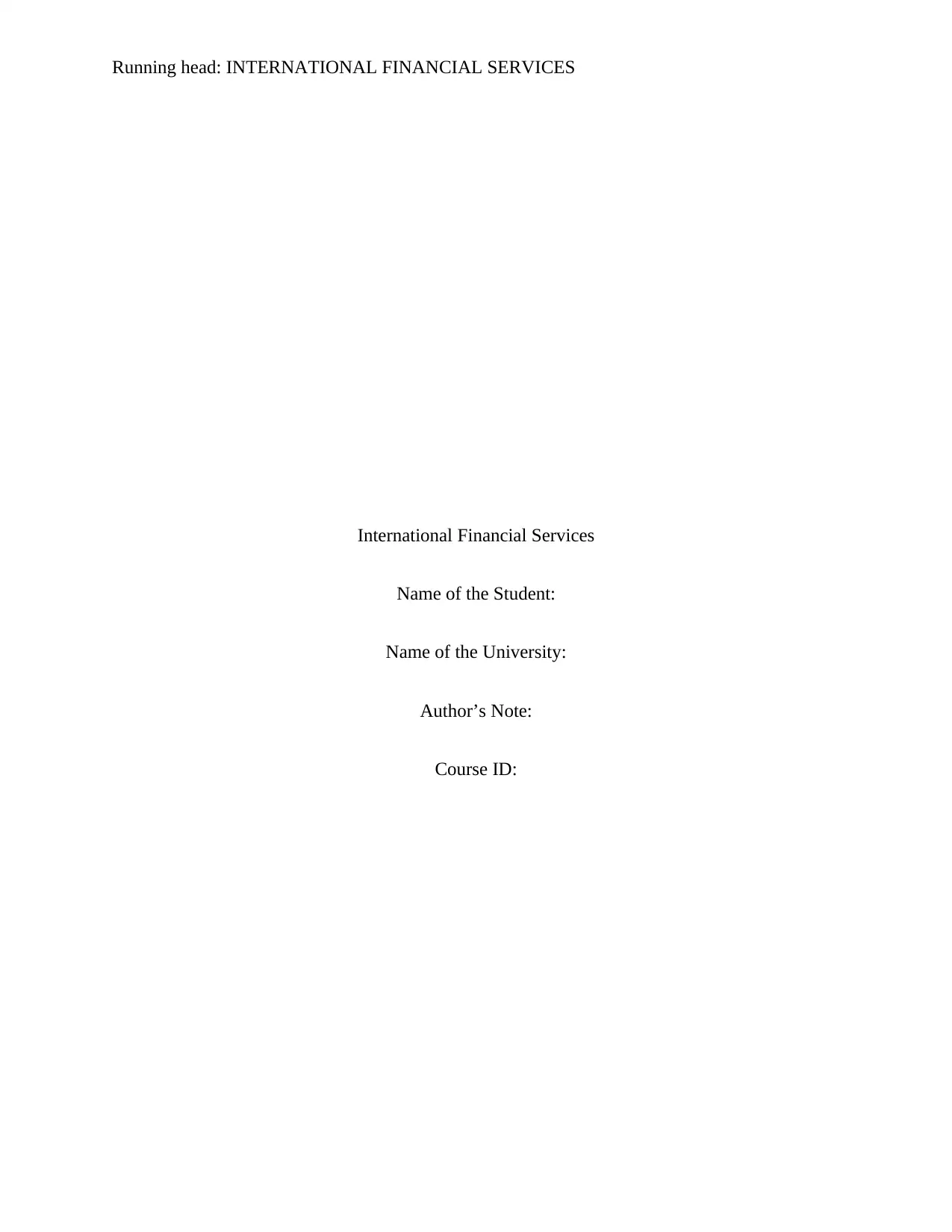
Running head: INTERNATIONAL FINANCIAL SERVICES
International Financial Services
Name of the Student:
Name of the University:
Author’s Note:
Course ID:
International Financial Services
Name of the Student:
Name of the University:
Author’s Note:
Course ID:
Paraphrase This Document
Need a fresh take? Get an instant paraphrase of this document with our AI Paraphraser
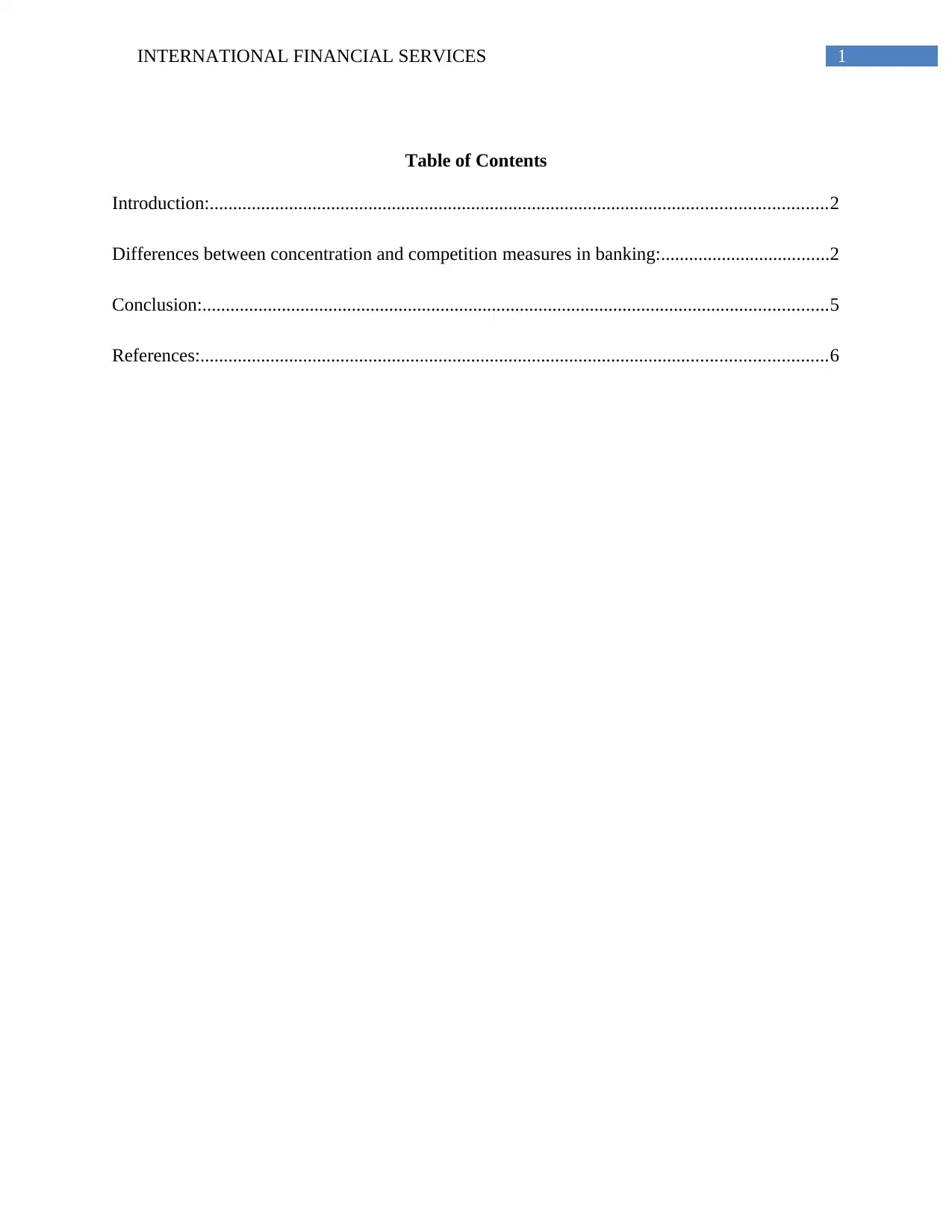
1INTERNATIONAL FINANCIAL SERVICES
Table of Contents
Introduction:....................................................................................................................................2
Differences between concentration and competition measures in banking:....................................2
Conclusion:......................................................................................................................................5
References:......................................................................................................................................6
Table of Contents
Introduction:....................................................................................................................................2
Differences between concentration and competition measures in banking:....................................2
Conclusion:......................................................................................................................................5
References:......................................................................................................................................6

2INTERNATIONAL FINANCIAL SERVICES
Introduction:
In the current era, both concentration and competition have become a recurrent topic in
the banking literature. More precisely, in the last decade, many empirical works have been
carried out for gauging the competition level inherent in banking markets. According to the
traditional view, rising competition might result in undesirable exercise of market power, in
which concentration impairs competition. However, this view has been contradicted vigorously
in recent times. The concentration and competition measures are critical to public policy
associated with welfare towards the banking market (Anginer, Demirguc-Kunt and Zhu 2014).
Both competition and concentration are associated with product markets as well as geographical
regions in empirical analyses and theory. The banks provide a variety of products, which do not
serve a particular market and explaining a relevant market includes undertaking preliminary
decision regarding potentially pertinent structural features like competition and concentration.
Differences between concentration and competition measures in banking:
The banking industry concentration implies the market share of each bank functioning in
the industry. If the concentration is greater, it implies increased prices for the customers and this
could result in upward trend in prices (Fiordelisi and Mare 2014). On the other hand, banking
industry competition implies the number of banks operating in the industry. In case of greater
concentration, price stability is present from which the customers would be benefitted
significantly.
Concentration measures in banking:
Introduction:
In the current era, both concentration and competition have become a recurrent topic in
the banking literature. More precisely, in the last decade, many empirical works have been
carried out for gauging the competition level inherent in banking markets. According to the
traditional view, rising competition might result in undesirable exercise of market power, in
which concentration impairs competition. However, this view has been contradicted vigorously
in recent times. The concentration and competition measures are critical to public policy
associated with welfare towards the banking market (Anginer, Demirguc-Kunt and Zhu 2014).
Both competition and concentration are associated with product markets as well as geographical
regions in empirical analyses and theory. The banks provide a variety of products, which do not
serve a particular market and explaining a relevant market includes undertaking preliminary
decision regarding potentially pertinent structural features like competition and concentration.
Differences between concentration and competition measures in banking:
The banking industry concentration implies the market share of each bank functioning in
the industry. If the concentration is greater, it implies increased prices for the customers and this
could result in upward trend in prices (Fiordelisi and Mare 2014). On the other hand, banking
industry competition implies the number of banks operating in the industry. In case of greater
concentration, price stability is present from which the customers would be benefitted
significantly.
Concentration measures in banking:
⊘ This is a preview!⊘
Do you want full access?
Subscribe today to unlock all pages.

Trusted by 1+ million students worldwide
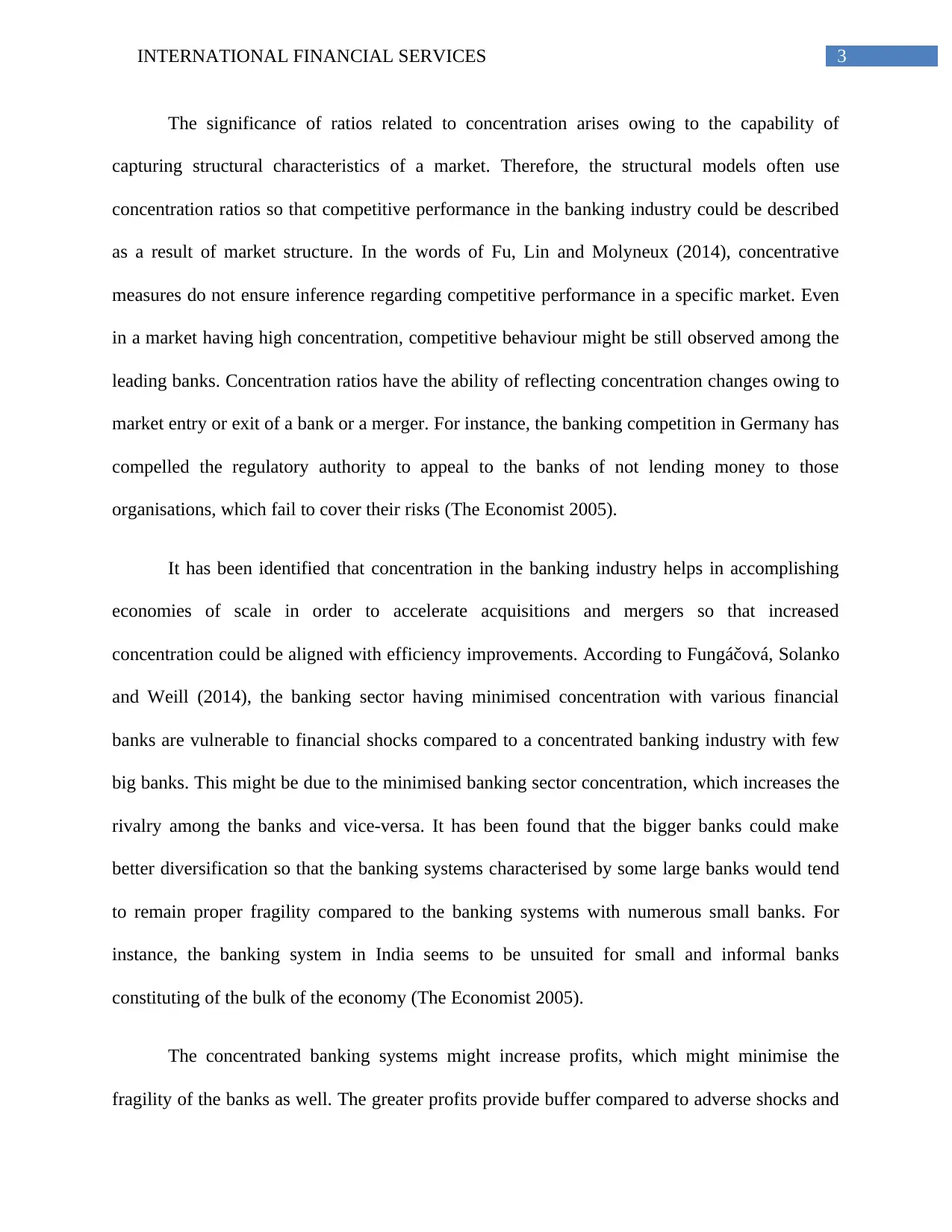
3INTERNATIONAL FINANCIAL SERVICES
The significance of ratios related to concentration arises owing to the capability of
capturing structural characteristics of a market. Therefore, the structural models often use
concentration ratios so that competitive performance in the banking industry could be described
as a result of market structure. In the words of Fu, Lin and Molyneux (2014), concentrative
measures do not ensure inference regarding competitive performance in a specific market. Even
in a market having high concentration, competitive behaviour might be still observed among the
leading banks. Concentration ratios have the ability of reflecting concentration changes owing to
market entry or exit of a bank or a merger. For instance, the banking competition in Germany has
compelled the regulatory authority to appeal to the banks of not lending money to those
organisations, which fail to cover their risks (The Economist 2005).
It has been identified that concentration in the banking industry helps in accomplishing
economies of scale in order to accelerate acquisitions and mergers so that increased
concentration could be aligned with efficiency improvements. According to Fungáčová, Solanko
and Weill (2014), the banking sector having minimised concentration with various financial
banks are vulnerable to financial shocks compared to a concentrated banking industry with few
big banks. This might be due to the minimised banking sector concentration, which increases the
rivalry among the banks and vice-versa. It has been found that the bigger banks could make
better diversification so that the banking systems characterised by some large banks would tend
to remain proper fragility compared to the banking systems with numerous small banks. For
instance, the banking system in India seems to be unsuited for small and informal banks
constituting of the bulk of the economy (The Economist 2005).
The concentrated banking systems might increase profits, which might minimise the
fragility of the banks as well. The greater profits provide buffer compared to adverse shocks and
The significance of ratios related to concentration arises owing to the capability of
capturing structural characteristics of a market. Therefore, the structural models often use
concentration ratios so that competitive performance in the banking industry could be described
as a result of market structure. In the words of Fu, Lin and Molyneux (2014), concentrative
measures do not ensure inference regarding competitive performance in a specific market. Even
in a market having high concentration, competitive behaviour might be still observed among the
leading banks. Concentration ratios have the ability of reflecting concentration changes owing to
market entry or exit of a bank or a merger. For instance, the banking competition in Germany has
compelled the regulatory authority to appeal to the banks of not lending money to those
organisations, which fail to cover their risks (The Economist 2005).
It has been identified that concentration in the banking industry helps in accomplishing
economies of scale in order to accelerate acquisitions and mergers so that increased
concentration could be aligned with efficiency improvements. According to Fungáčová, Solanko
and Weill (2014), the banking sector having minimised concentration with various financial
banks are vulnerable to financial shocks compared to a concentrated banking industry with few
big banks. This might be due to the minimised banking sector concentration, which increases the
rivalry among the banks and vice-versa. It has been found that the bigger banks could make
better diversification so that the banking systems characterised by some large banks would tend
to remain proper fragility compared to the banking systems with numerous small banks. For
instance, the banking system in India seems to be unsuited for small and informal banks
constituting of the bulk of the economy (The Economist 2005).
The concentrated banking systems might increase profits, which might minimise the
fragility of the banks as well. The greater profits provide buffer compared to adverse shocks and
Paraphrase This Document
Need a fresh take? Get an instant paraphrase of this document with our AI Paraphraser
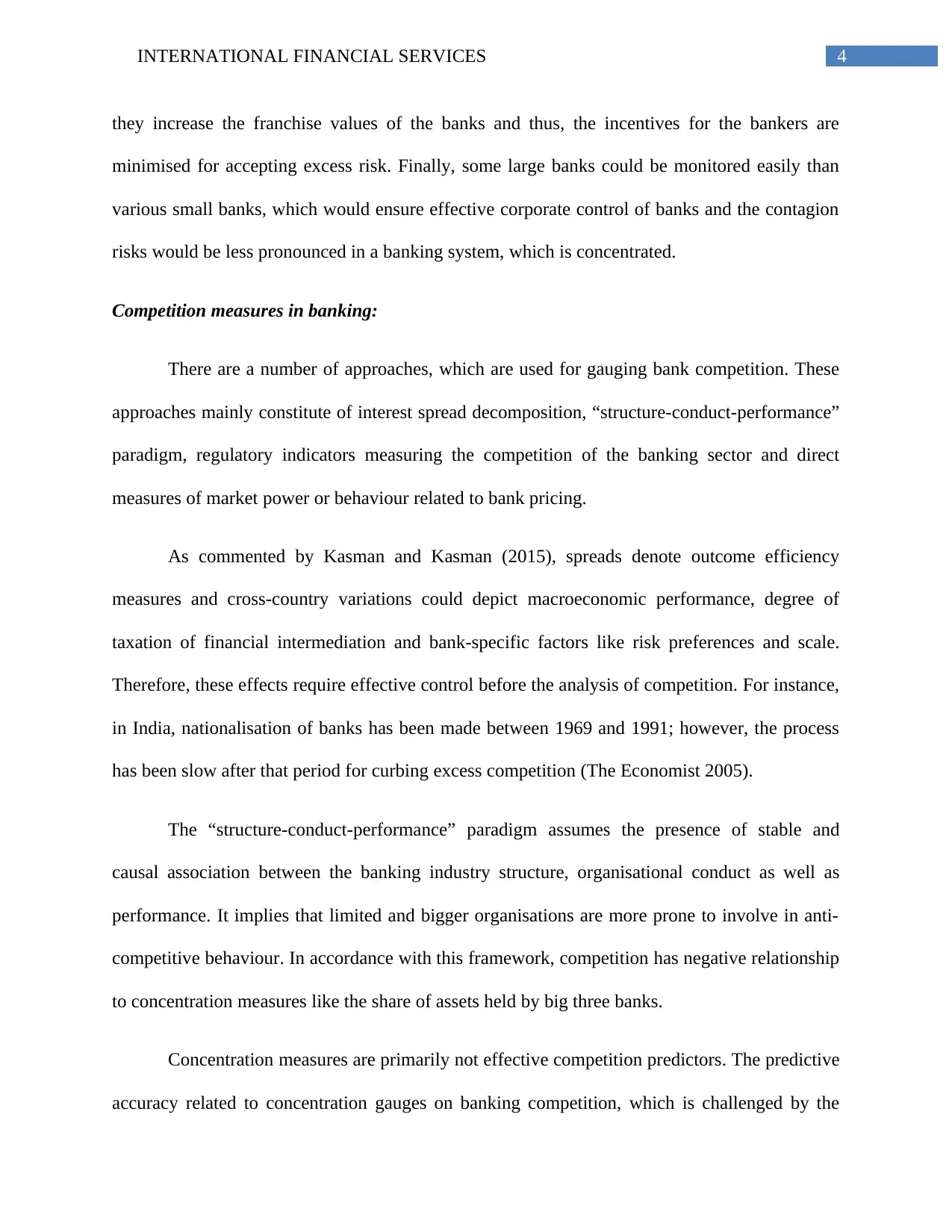
4INTERNATIONAL FINANCIAL SERVICES
they increase the franchise values of the banks and thus, the incentives for the bankers are
minimised for accepting excess risk. Finally, some large banks could be monitored easily than
various small banks, which would ensure effective corporate control of banks and the contagion
risks would be less pronounced in a banking system, which is concentrated.
Competition measures in banking:
There are a number of approaches, which are used for gauging bank competition. These
approaches mainly constitute of interest spread decomposition, “structure-conduct-performance”
paradigm, regulatory indicators measuring the competition of the banking sector and direct
measures of market power or behaviour related to bank pricing.
As commented by Kasman and Kasman (2015), spreads denote outcome efficiency
measures and cross-country variations could depict macroeconomic performance, degree of
taxation of financial intermediation and bank-specific factors like risk preferences and scale.
Therefore, these effects require effective control before the analysis of competition. For instance,
in India, nationalisation of banks has been made between 1969 and 1991; however, the process
has been slow after that period for curbing excess competition (The Economist 2005).
The “structure-conduct-performance” paradigm assumes the presence of stable and
causal association between the banking industry structure, organisational conduct as well as
performance. It implies that limited and bigger organisations are more prone to involve in anti-
competitive behaviour. In accordance with this framework, competition has negative relationship
to concentration measures like the share of assets held by big three banks.
Concentration measures are primarily not effective competition predictors. The predictive
accuracy related to concentration gauges on banking competition, which is challenged by the
they increase the franchise values of the banks and thus, the incentives for the bankers are
minimised for accepting excess risk. Finally, some large banks could be monitored easily than
various small banks, which would ensure effective corporate control of banks and the contagion
risks would be less pronounced in a banking system, which is concentrated.
Competition measures in banking:
There are a number of approaches, which are used for gauging bank competition. These
approaches mainly constitute of interest spread decomposition, “structure-conduct-performance”
paradigm, regulatory indicators measuring the competition of the banking sector and direct
measures of market power or behaviour related to bank pricing.
As commented by Kasman and Kasman (2015), spreads denote outcome efficiency
measures and cross-country variations could depict macroeconomic performance, degree of
taxation of financial intermediation and bank-specific factors like risk preferences and scale.
Therefore, these effects require effective control before the analysis of competition. For instance,
in India, nationalisation of banks has been made between 1969 and 1991; however, the process
has been slow after that period for curbing excess competition (The Economist 2005).
The “structure-conduct-performance” paradigm assumes the presence of stable and
causal association between the banking industry structure, organisational conduct as well as
performance. It implies that limited and bigger organisations are more prone to involve in anti-
competitive behaviour. In accordance with this framework, competition has negative relationship
to concentration measures like the share of assets held by big three banks.
Concentration measures are primarily not effective competition predictors. The predictive
accuracy related to concentration gauges on banking competition, which is challenged by the
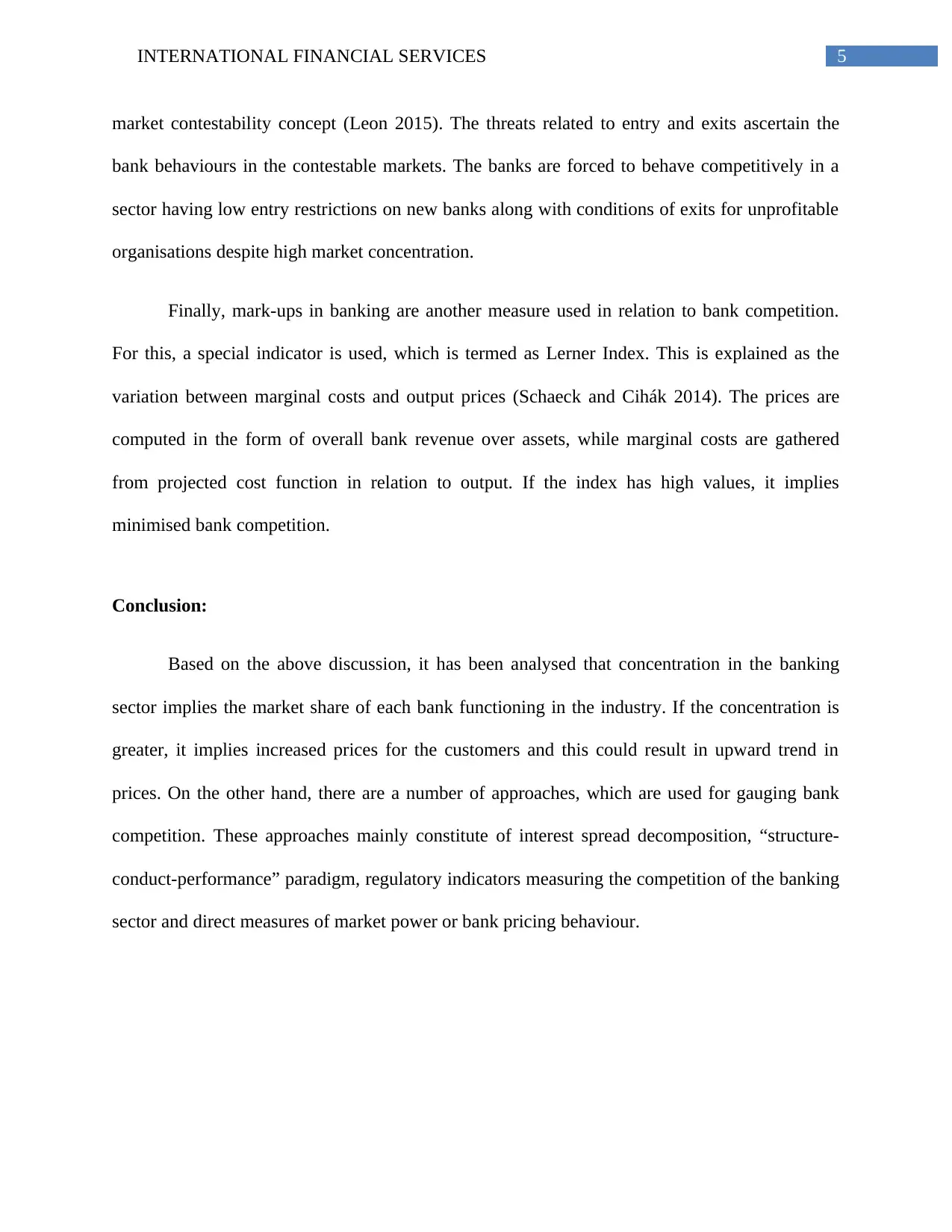
5INTERNATIONAL FINANCIAL SERVICES
market contestability concept (Leon 2015). The threats related to entry and exits ascertain the
bank behaviours in the contestable markets. The banks are forced to behave competitively in a
sector having low entry restrictions on new banks along with conditions of exits for unprofitable
organisations despite high market concentration.
Finally, mark-ups in banking are another measure used in relation to bank competition.
For this, a special indicator is used, which is termed as Lerner Index. This is explained as the
variation between marginal costs and output prices (Schaeck and Cihák 2014). The prices are
computed in the form of overall bank revenue over assets, while marginal costs are gathered
from projected cost function in relation to output. If the index has high values, it implies
minimised bank competition.
Conclusion:
Based on the above discussion, it has been analysed that concentration in the banking
sector implies the market share of each bank functioning in the industry. If the concentration is
greater, it implies increased prices for the customers and this could result in upward trend in
prices. On the other hand, there are a number of approaches, which are used for gauging bank
competition. These approaches mainly constitute of interest spread decomposition, “structure-
conduct-performance” paradigm, regulatory indicators measuring the competition of the banking
sector and direct measures of market power or bank pricing behaviour.
market contestability concept (Leon 2015). The threats related to entry and exits ascertain the
bank behaviours in the contestable markets. The banks are forced to behave competitively in a
sector having low entry restrictions on new banks along with conditions of exits for unprofitable
organisations despite high market concentration.
Finally, mark-ups in banking are another measure used in relation to bank competition.
For this, a special indicator is used, which is termed as Lerner Index. This is explained as the
variation between marginal costs and output prices (Schaeck and Cihák 2014). The prices are
computed in the form of overall bank revenue over assets, while marginal costs are gathered
from projected cost function in relation to output. If the index has high values, it implies
minimised bank competition.
Conclusion:
Based on the above discussion, it has been analysed that concentration in the banking
sector implies the market share of each bank functioning in the industry. If the concentration is
greater, it implies increased prices for the customers and this could result in upward trend in
prices. On the other hand, there are a number of approaches, which are used for gauging bank
competition. These approaches mainly constitute of interest spread decomposition, “structure-
conduct-performance” paradigm, regulatory indicators measuring the competition of the banking
sector and direct measures of market power or bank pricing behaviour.
⊘ This is a preview!⊘
Do you want full access?
Subscribe today to unlock all pages.

Trusted by 1+ million students worldwide
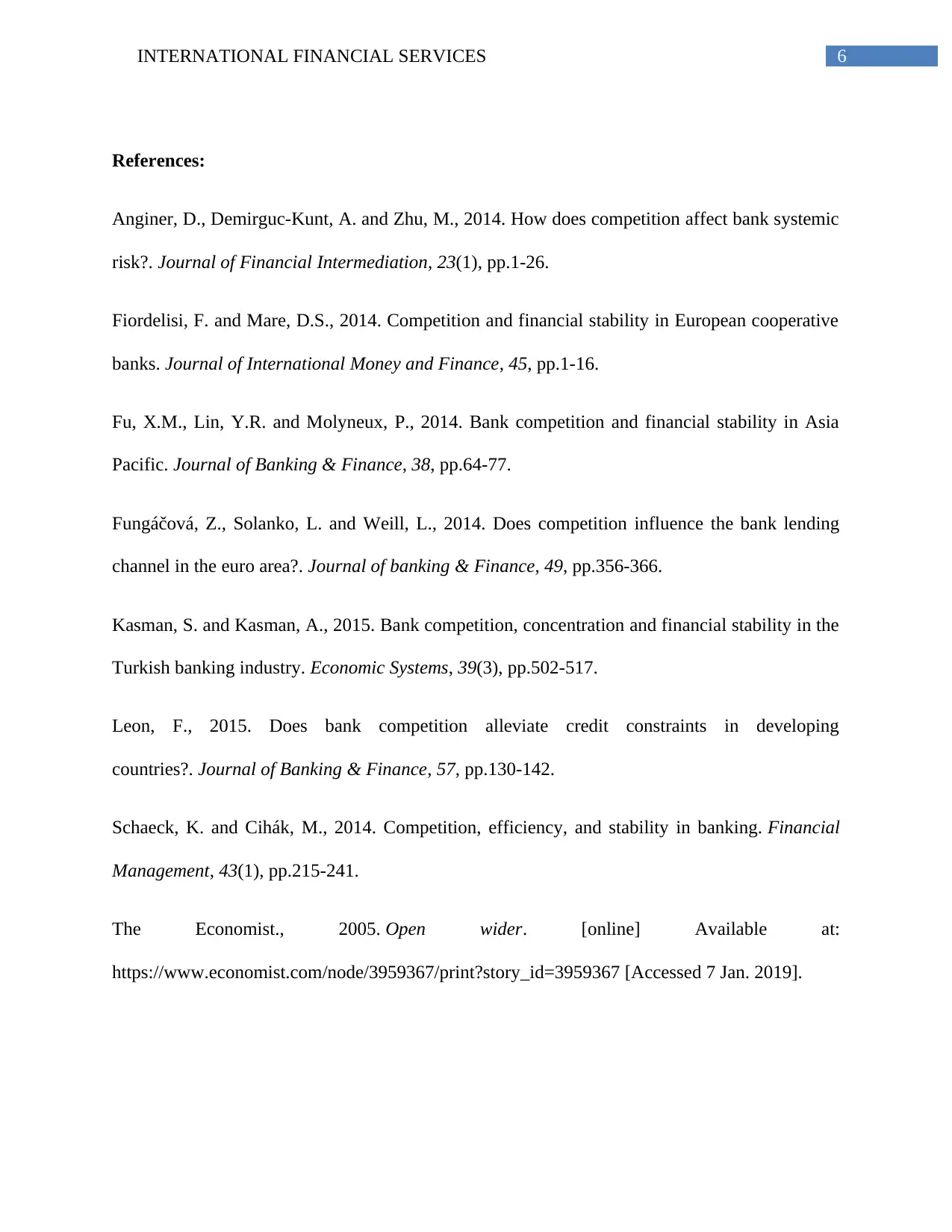
6INTERNATIONAL FINANCIAL SERVICES
References:
Anginer, D., Demirguc-Kunt, A. and Zhu, M., 2014. How does competition affect bank systemic
risk?. Journal of Financial Intermediation, 23(1), pp.1-26.
Fiordelisi, F. and Mare, D.S., 2014. Competition and financial stability in European cooperative
banks. Journal of International Money and Finance, 45, pp.1-16.
Fu, X.M., Lin, Y.R. and Molyneux, P., 2014. Bank competition and financial stability in Asia
Pacific. Journal of Banking & Finance, 38, pp.64-77.
Fungáčová, Z., Solanko, L. and Weill, L., 2014. Does competition influence the bank lending
channel in the euro area?. Journal of banking & Finance, 49, pp.356-366.
Kasman, S. and Kasman, A., 2015. Bank competition, concentration and financial stability in the
Turkish banking industry. Economic Systems, 39(3), pp.502-517.
Leon, F., 2015. Does bank competition alleviate credit constraints in developing
countries?. Journal of Banking & Finance, 57, pp.130-142.
Schaeck, K. and Cihák, M., 2014. Competition, efficiency, and stability in banking. Financial
Management, 43(1), pp.215-241.
The Economist., 2005. Open wider. [online] Available at:
https://www.economist.com/node/3959367/print?story_id=3959367 [Accessed 7 Jan. 2019].
References:
Anginer, D., Demirguc-Kunt, A. and Zhu, M., 2014. How does competition affect bank systemic
risk?. Journal of Financial Intermediation, 23(1), pp.1-26.
Fiordelisi, F. and Mare, D.S., 2014. Competition and financial stability in European cooperative
banks. Journal of International Money and Finance, 45, pp.1-16.
Fu, X.M., Lin, Y.R. and Molyneux, P., 2014. Bank competition and financial stability in Asia
Pacific. Journal of Banking & Finance, 38, pp.64-77.
Fungáčová, Z., Solanko, L. and Weill, L., 2014. Does competition influence the bank lending
channel in the euro area?. Journal of banking & Finance, 49, pp.356-366.
Kasman, S. and Kasman, A., 2015. Bank competition, concentration and financial stability in the
Turkish banking industry. Economic Systems, 39(3), pp.502-517.
Leon, F., 2015. Does bank competition alleviate credit constraints in developing
countries?. Journal of Banking & Finance, 57, pp.130-142.
Schaeck, K. and Cihák, M., 2014. Competition, efficiency, and stability in banking. Financial
Management, 43(1), pp.215-241.
The Economist., 2005. Open wider. [online] Available at:
https://www.economist.com/node/3959367/print?story_id=3959367 [Accessed 7 Jan. 2019].
1 out of 7
Related Documents
Your All-in-One AI-Powered Toolkit for Academic Success.
+13062052269
info@desklib.com
Available 24*7 on WhatsApp / Email
![[object Object]](/_next/static/media/star-bottom.7253800d.svg)
Unlock your academic potential
Copyright © 2020–2026 A2Z Services. All Rights Reserved. Developed and managed by ZUCOL.





